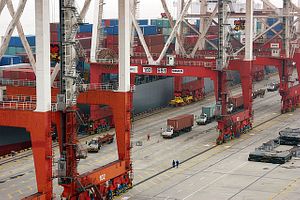Early July saw the Fifth Intersessional Ministerial Meeting of the Regional Comprehensive Economic Partnership (RCEP), with Singapore and Japan acting as joint hosts in adopting the Tokyo Declaration. With this declaration, the participating countries committed to working together to conclude the RCEP negotiations.
Meanwhile, in late July, lead negotiators from eleven Trans-Pacific Partnership (TPP) member states met in Hakone, exchanged information about their own domestic procedures and confirmed a policy of welcoming new members from countries and regions once the TPP goes into effect. At present, the TPP has already been ratified by Mexico, Japan and Singapore. New Zealand and Canada are also expected to follow suit immediately, and the TPP is set to go into effect early next year.
The protectionist trade policy of the U.S. administration of Donald J. Trump has created significant international turbulence. America’s trade war with China, the primary target of the Trump administration’s trade policy, is intensifying. This has led to concerns about a crisis in the liberal economic order, widely credited for bringing global development and prosperity in recent decades.
Given this mounting concern, many observers are looking with hope to the TPP 11. While Trump is president at least, United States looks unlikely to return to the TPP. On the other hand, Thailand and Colombia have both expressed interest in the TPP 11. Clearly, the TPP 11 has appeal, although the RCEP is also seen as significant in terms of the liberal economic order.
Caution is warranted, however. First, although the appeal of the TPP 11 is increasing, the TPP 11 is hardly all-encompassing. Obviously, the absence of the United States leaves a gaping hole. In addition, China, the driver of regional growth and the core of many supply chains, has not joined. India, another fast growing giant, is also absent. In addition, the division of the Association of Southeast Asian Nations (ASEAN) will remain unchanged for some time, even if Thailand joins the TPP in the near future.
The importance of the RCEP is that it is a framework that encompasses key regional and emerging economies, such as China, India and Japan, as well as the ASEAN member states. The concern with the RCEP lies with the nature of the final agreement and particularly whether its rules will be consistent with the liberal economic order. The Guiding Principles and Objectives for Negotiating the RCEP state that the RCEP should further deepen the free trade agreements of the existing ASEAN+1. But they also note that such initiatives should be implemented with a focus on the different situations of each country. In addition, the principles confirm that flexibility for the varying stages of development should be included in the articles of any agreement. Certainly, this kind of flexibility and consideration are necessary in setting economic rules for a diverse Asian region. However, these factors could also be used to justify delays in liberalization.
Trump’s “America First” trade policy is not the only factor threatening the liberal economic order. China’s aggressive approach to forming a broader economic order through its Belt and Road initiative also has very real repercussions. Of course, as the agglomeration of high-tech industries in Shenzhen shows, it is also true that in China, it is possible to see examples of industrial development driven by free innovation without state intervention. But the projects of the Belt and Road initiative, which stretches across Southeast Asia, Central Asia, West Asia, East Africa and Europe, involve infrastructure development carried out mainly by Chinese state-owned companies, which are funded by the Export-Import Bank of China. That is, Chinese external economic policies that are characterized by the Belt and Road initiative are policies that lean more towards state capitalism rather than the expansion of activities depending on free and open markets. Those policies include elements that are incompatible with the liberal economic order.
Currently, the RCEP negotiations of which China is a part are not considering rules on the regulation and transparency of state-owned companies, the prevention of corruption, and guarantees of workers’ rights, all of which are included in the TPP and the TPP 11. Laying down rules in these areas is important in terms of curbing the expansion of state capitalism, preventing social distortions that occur amid the progress of globalization, and strengthening the healthy liberal economic order. As such, the absence of moves to form rules in these areas reveals the RCEP’s limitations as a framework for preserving the liberal economic order.
Those countries, Japan among them, that seek to defend the liberal economic order have no choice but to support the TPP 11 and the RCEP for the time being, participating in and strengthening these bodies. But neither grouping is sufficient to protect and strengthen the liberal economic order in Asia. The issue for the region will be to facilitate the consistency of the rules set by the TPP 11 and the RCEP and form a truly comprehensive, high-level framework.
Mie Oba is a professor at the Tokyo University of Science.
































